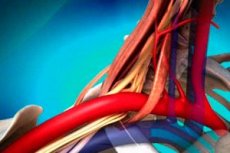Syndrome of anterior staircase
Last reviewed: 23.04.2024

All iLive content is medically reviewed or fact checked to ensure as much factual accuracy as possible.
We have strict sourcing guidelines and only link to reputable media sites, academic research institutions and, whenever possible, medically peer reviewed studies. Note that the numbers in parentheses ([1], [2], etc.) are clickable links to these studies.
If you feel that any of our content is inaccurate, out-of-date, or otherwise questionable, please select it and press Ctrl + Enter.

The syndrome of the anterior staircase (also called Nuffziger syndrome - by the name of the author who described this disease for the first time - HC Naffziger, 1937) is one of the most frequent variants of pathology in the combined category of syndromes observed in the upper sternum entrance.
Causes of the syndrome of anterior staircase
The cause of the syndrome is a reflex muscle spasm, which arises from the irritation of the roots due to the development of cervical osteochondrosis. The front stair is located in the interval between the transverse ends of the 3-6 vertebrae of the neck, and also the 1st rib. In this place is also located the lower region of the brachial plexus together with the artery under the collarbone - they are squeezed due to the narrowing of the muscle.
 [4]
[4]
Pathogenesis
In Nuffziger's syndrome, the patient is sealed, spasmodized, or thickened by the designated muscle, and in addition, the secondary compression of the bundle of vascular-nerve endings (the vein with the artery, located under the clavicle, and along with them a bundle inside the brachial plexus that is formed from rootlets of the C8- T1) in the region of the interstitial space (between the 1st rib and the spasmodic muscle).
Symptoms of the syndrome of anterior staircase
This syndrome is characterized by the following symptoms: pain in the neck, which pass down the arm from the ulnar margin, and in addition, painful sensations with tension in the arm. The pain syndrome becomes stronger at night, and also in case of deep inspiration and attempts to tilt the head on a healthy side. In some cases, the pain is able to pass and into the shoulder girdle, armpits and sternum. Cystic weakness can be felt (mainly in 4-5 fingers), and sometimes there is an appearance of vasomotor disturbances in the hand. Together with this, a tingling sensation in the hand can be felt with numbness, especially in the forearm, and also along the ulnar carpal side.
As a result of compression of the artery due to spasm of the anterior staircase muscle, the supraclavicular fossa begins to swell, and in addition, the amplitude of arterial fluctuations and the level of the blood pressure decrease (in the case of turning the head in the opposite side of the muscle that is squeezed). Together with this, it is possible to develop paresthesias in the upper limb, as well as headaches.
There may also appear cyanosis or pallor, as well as swelling in the area of the hand, and in addition to decrease the skin temperature. Possible coarsening of the skin, the development of osteoporosis carpal bones, as well as the development of brittle nails. When the palpation of the tightened muscle, the patient feels pain.
Complications and consequences
In the case of an increase in the manifestations of the syndrome, some complications may develop: carotid muscle hypotrophy, accompanied by symptoms of poor blood circulation in the limb. This condition is similar to Raynaud's disease (a decrease in the pulse within the radial artery, edema of the hand, the appearance of hypertonic crises caused by cold, etc.).
Diagnostics of the syndrome of anterior staircase
At the heart of the diagnostic process is a clinical picture of the disease: as a result of palpation on the neck, the patient shows a unilateral swelling and thickening (to the right or left, depending on which of the muscles is squeezed) - this area is also painful.
To clarify the diagnosis, they perform the so-called Edson's test: to do this, the patient's hand is taken back, and then he must tilt his head. As a result, the compression of the spasmodic muscle with respect to the subclavian artery increases. In case the sample is positive - the pain will increase, and the hand will numb. In this case, pulsation in the region of the radial artery will weaken or disappear altogether.
During the diagnostics, such instrumental procedures as rheovasography, oscillography, and in addition volumetric sphygmography are performed.
Differential diagnosis
Who to contact?
Treatment of the syndrome of anterior staircase
The main goal of the treatment course is to eliminate discomforting sensations (numbness and pain), and in addition restore the natural healthy state of the vessels and muscles along with the motor function of the upper limb. At the initial stage, the treatment is performed by conservative methods.
In the process of treatment, various medications are used - a novocain blockade of the spasmodic muscle is performed (hydrocortisone administration is permitted as an aid). Also in the place of compression of the nerve can be administered diprospan. At the same time, anti-inflammatory drugs (salicylates with brufen), anesthetics, and vasodilating drugs (such as no-spa, complamine and nikoshpan) are prescribed.
Complex conservative treatment also includes the use of vitamins from category B.
Among the physiotherapeutic procedures - massage compression area, UHF, exposure to diadynamic currents, as well as electrophoresis of salicylates or novocaine.
Performed and procedures of therapeutic physical education, is performed acupuncture, isometric muscle relaxation, and in addition, warming up the sore spot with the help of dry heat.
In the case when conservative therapy did not give the necessary results, a surgical operation can be prescribed. At the same time, the procedure of a scalenotomy (resection of the muscle) or removal of a part of the cervical rib is performed.

